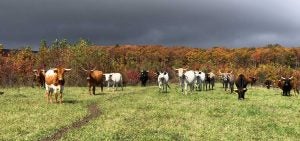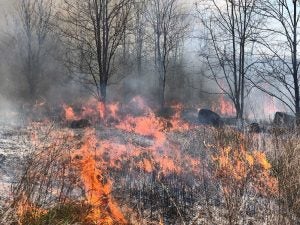It’s about land management, profitability, and ecology. In an ideal world, these things are perfectly balanced to the benefit of the environment and the landowner. At one farm in Eastern Tennessee, we’re trying to demonstrate a management strategy that is affordable, effective and results in profits and an improved ecology. We’re using cattle and controlled burns — two tools available to most farmers — to do it.
An owner’s perspective
We’re working through this process on a 5,000-acre farm called Coal Creek Farm, which has been assembled over 12 years. The first acquisition had been clear-cut by the previous (absentee) owners and had historically been occupied by squatters, occasionally with a few cattle. The squatters moved in after a clear-cut, set fire to a flat area, and then grazed cows on the recently burned land. The burn encouraged growth of enough native grasses to support a few cows. These grasses required no maintenance as they occurred naturally in the area. The native grasses provided a subsistence living for farmer and cow, as the cattle were fed at virtually no cost. Still, the process was haphazard and therefore unreliable and inappropriate for a modern working farm.
But, if the process could be managed for reliability, we might be able to raise cattle more affordably, restore (wild animal friendly) native grasses and, just maybe, increase profitability.
As a landowner, my goal is to be able to feed cattle while also encouraging regrowth of native grasses. I say “regrowth” rather than “restoration” because it’s impossible to determine a point in time to peg efforts. Science is unclear as to how and when each plant arrived in the area. Were the original plants brought by Native Americans one thousand years ago? Or were these seeds brought from another state by a strong wind storm? It is not clear.
What is clear is that there are dormant seeds hibernating underground. Fire clears an area and encourages the growth of these “sleeping” seeds by “waking” them up. Controlled fires have been part of land management since the grasslands and prairies were occupied by Native Americans. As a landowner interested in environmental restoration, I am focused on mimicking nature as closely and systematically as possible. Adapting modern rules and techniques to old fashioned fire does indeed encourage the growth of native grasses. And these grasses do provide part time foraging for cattle as well as shelter and food for native birds and insects. But burning does not fully replicate the natural cycle, as there are no more large herbivores (bison, elk) roaming the Plateau. But, there are cows.

In Tennessee, Black Angus cows are most popular. But, Black Angus are a persnickety breed which generally avoid thickets (the regrowth after a clear cut) after about three years of growth. On the other hand, Longhorn Cattle are a hearty and fearless group. They are more willing to explore for food in a thicket. Right now, this breed does not enjoy the same market demand as Black Angus; but Angus primarily feed on non-native, high maintenance, cool season grasses. The cost to raise them is greater than longhorn when factors like lime, mowing, fertilizer and other management costs are factored in.
Here’s the thing: Between clear-cutting and thickets, there’s an opportunity to use controlled burns so that the thickets don’t grow, but the native grasses do. Warm season grasses can be encouraged to grow and feed the cattle in ways more synced with nature. At Coal Creek we believe that by burning, we can begin to develop forage for the hearty Longhorn and maybe later, the pickier Angus. Burned thicket can provide foraging opportunities with minimal fertilizer, pesticides, tractors and mechanized human intervention.
The science of fire
Burning is dangerous, complicated and requires in-depth understanding of nature and surroundings. Up until the mid-1950s, fires were a regular part of the natural ecosystem in the U.S. They were caused by nature (lightning) or by man. Native Americans used repeated burns to create mountaintop “balds.” These areas provided site lines to watch for enemy tribes as well as roaming buffalo. These “balds” also attracted buffalo, which would stop and forage on the native grasses. The multi-purpose “balds” acted as magnets for herds, which in turn gave Native Americans easy prey.
In a natural system, burned areas also acted as buffers to prevent fires from running out of control. Imagine a fire raging up a hill, and then suddenly it runs into an area which had been burned a year earlier. Without combustible brown leaves, old sticks and dead plant matter, the fire has no fuel and will naturally die out. But what if there are no previously burned areas? The fire continues to rage on. Shortly after World War II, fires were deemed a threat to fast-growing suburban populations. The federal government implemented the Smoky the Bear program. Fires were successfully prevented throughout the country. Homes and lives were saved, but combustible matter was left to accumulate. In 2016, an area around Gatlinburg, Tennessee, caught fire. There was so much unburned fuel in the woods that the fire raged out of control.
Firefighters faced an uphill battle in light of decades of accumulated fuel. A prescribed burn program would have reduced the fuel on the ground and created preventative “burn lanes.”
Fires have had a bad name for decades, but safely executed controlled burns are a part of a smart management plan. Fire certification classes are often offered at no cost by local farm extension centers. State wildlife management resources also offer help with controlled burns. Local permit requirements provide “how to” materials for interested parties. At Coal Creek Farm we take advantage of as many resources as we can in order to burn safely. So far the results have been excellent. We have created burned buffer lanes making large scale out of control fires less likely. We have also begun the process of naturally reintroducing native foraging grasses. Native grasses such as Big Blue Stem, Little Blue Stem and Indian Grass are beginning to appear. And then there are the longhorns…
It’s great when a plan turns out
Our first test site on Coal Creek began Spring 2018. After two successive years of controlled burns, we chose a 60-acre area where native grasses had begun to re-emerge. We fenced in the area and introduced a herd of thirty Longhorn cow/calf pairs. The only cost to the experiment was the effort required to burn the area twice, as well as the cost to surround the enclosure with fencing, which is required to keep cattle anyway. The big question at hand was how long would the longhorns last in the enclosure before running out of food? In Cumberland County, Tennessee, there is an adage that says, “an acre and a half for a cow and her calf.”

In theory, for example, 15-acres of cool season, costly, maintained grasses provide for a herd of 10 cows. But the acre and a half relates to the cool season. If the longhorns could forage for a month or so on burned warm season grasses, the experiment would be deemed a success. Moving the cows off of the cool season grasses in the month of May, for example, would not only allow for a month of low-cost foraging, but it would also have the added benefit of allowing a cool season grass area to grow free of grazing. The burned 60 acres had minimal recurring costs (burning 60 acres takes about a day with a handful of human helpers,) and would be a “free” bonus month of fodder.
We turned the longhorns into the thicket and anxiously waited to see how long they would last. At first, every day, I took the long ATV ride to the experiment site in order to check on the Longhorns. There were weekly check-ups. Nearly three months after introducing longhorns, the cows were still happily foraging in the burned thicket area.
The experiment was such a success, that we decided to move the cows out of the burned 60-acres not because they looked hungry, but because our advising biologist, Dr. Dwayne Estes, was concerned that the cows might eat too many of the re-emergent native grasses and reduce future seeding opportunities. Burning thicket did indeed provide native grass fodder for cattle. Watching my cows eat free native food in the company of newly returning native animals is my idea of farmer heaven. Our first burn/graze experiment has encouraged us to fence more burned thickets, and to expand our burning program.
Burned thickets do indeed provide foraging for cows. While these areas cannot replace all cool season, maintained grass fields, there is a role for this type of ecology in the life cycle of a Cumberland Plateau Farm, and perhaps, farms elsewhere.
My hope is that by implementing and studying burn/graze techniques we can encourage business-friendly natural areas on many local farms. The return of native flora and fauna is good for the economy, environment, and for the quality of life on Tennessee’s Cumberland Plateau.
George Lindemann owns 5,000 acres on his farm in Tennessee. He cultivates native grasses to encourage the repopulation of wildlife and to cost-effectively feed cattle and has worked with scientists to develop best management practices. His blog can be found here.



